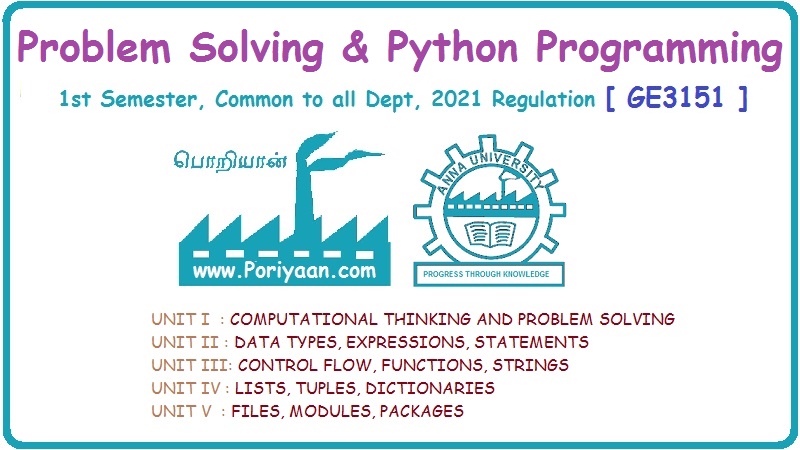Problem Solving and Python Programming: UNIT IV: Lists, Tuples, Dictionaries
Lists
Syntax, Example Program | Python Programming
The values in the list are called elements or items. These elements are separated by commas and enclosed within the square bracket.
Lists
AU
: Dec.-19, Marks 10
•
List is a sequence of values.
•
String is also sequence of values. But in string this sequence is of
characters. On the other hand, in case of List the values can be of any type.
•
The values in the list are called elements or items. These elements are
separated by commas and enclosed within the square bracket.
For
example
(10,20,30,40]
# list of integers
['aaa','bbb','ccc']
#list of strings
['a',10,20,'b',33.33]
#mixed list
[10,20,['a','b','d']]
#nested list
•
The list within another list is called nested list.
•
The list that contains no element is called empty list. The empty list is
represented
by
[]
1. List Operations
There
are two operations that can be performed using operators such as + and *
1.
Concatenation using +
The
two lists can be created and can be joined using + operator. Following
screenshot illustrates it.
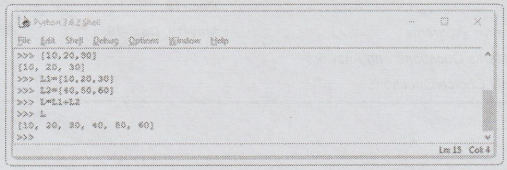
2.
Repetition using *
The
* is used to repeat the list for number of times. Following screenshot
illustrates it.

2. List Slices
•The
: operator used within the square bracket that it is a list slice and not the
index of the list
>>>
a=[10,20,30,40,50,60]
>>>
a[1:4]
[20,
30, 40]
>>>
a[:5]
[10,
20, 30, 40, 50)
>>>
a[4]
[50,
60]
>>>
a[:]
[10,
20, 30, 40, 50, 60]
>>>
•
If we omit the first index then the list is considered from the beginning. And
if we omit the last second index then slice goes to end.
•
If we omit both the first and second index then the list will be displayed from
the beginning to end.
•
Lists are mutable. That means we can change the elements of the list. Hence it
is always better to make a copy of the list before performing any operation.
•
For example
>>>
a=[10,20,30,40,50]
>>>
a[2:4]=[111,222,333]
>>>
a
[10,
20, 111, 222, 333, 50)
>>>
3. List Methods
List
Methods
1)
append(): This method is to add the element at the last
position of the list.
Syntax
:
list.append(element)
Example
:
>>>
a=[10,20,30]
>>>
a.append(40) #adding element 40 at the end
>>>
a
[10,
20, 30, 40]
>>>
b=['A', 'B', 'C']
>>>
b.append('D') #adding element D at the end
>>>
b
['A',
'B', 'C', 'D')
>>>
2)
extend(): The extend function takes the list as an argument
and appends this list at the end of old list.
Syntax
:
List1.extend(List2)
Where
List2 is added at the end of List1
Example
:
>>>
a={10,20,30]
>>>
b=['a','b', 'c']
>>>
a.extend(b)
>>>
a
[10,
20, 30, 'a', 'b', 'c']
>>>
3)
insert(): This function allows to insert the desired element
at specified position.
Syntax
:
List.insert(position,
element)
Where
the first parameter is a position at which the element is to be inserted. The
element to be inserted is the second parameter in this function.
Example
:
a=[10,20,30]
a.insert(2,25)
print("List
a = ",a)
Output
will be
List
a = [10, 20, 25, 30)
>>>
4)
pop() :
This
function removes the element specified by the index.
Syntax
:
List.pop(index)
The
index represent the location of element in the list and the element specified
by the index will be deleted and returned. The parameter passed to the list is
optional. If no parameter is passed, the default index -1 is passed as an
argument which returns the last element.
Example
#list
created
a=[10,20,30,40,50]
ret_val=a.pop(2)
print("The
deleted element is = ",ret_val)
print("The
modified list is = ",a)
Output
The
deleted element is = 30
The
modified list is = [10, 20, 40, 50)
>>>
Pop
when no parameter is passed
Syntax
List.pop()
Example
#list
created
a
= [10,20,30,40,50]
ret_val=a.pop()
print("The
deleted element is = ",ret_val)
print("The
modified list is = ",a)
Output
The
deleted element is = 50
The
modified list is = [10, 20, 30, 40)
Pop()
when negative parameter is passed
Syntax
List.pop(negative
index)
Example
#
Creation of list
a
= (10,20,30,40,50]
#
When -1 is passed
#
Pops Last Element
print("\nWhen
-1 is passed:')
print('Return
Value:', a.pop(-1))
print('Updated
List:', a)
#
When -3 is passed
#
Pops Third Last Element
print("\nWhen
-3 is passed:')
print('Return
Value: ', a.pop(-3))
print('Updated
List:', a)
Output
When
-1 is passed:
Return
Value: 50
Updated
List: [10, 20, 30, 40]
When
-3 is passed:
Return
Value: 20
Updated
List: [10, 30, 40]
>>>
5)
remove : The remove method deletes the element which is
passed as a parameter. It actually removes the first matching element.
Syntax
:
List.remove(element)
Example
:
>>>
a={10,20,30,20,40,50]
>>>
a.remove(20)
>>>
print(a)
[10,
30, 20, 40, 50]
6)
erase(): This method erases all the elements of the list.
After this operation the list becomes empty.
Syntax
:
List.clear()
Example
:
>>>
a={10,20,30,40,50]
>>>
a.clear()
>>>
print(a)
>>>
7)
del(): This method deletes all the elements within the
given range.
Syntax
:
List.del(a:b)
The
element within the range a to b get deleted by this method.
Example
:
>>>
a=['a','b','c','d', 'e']
>>>
del a[2:4]
>>>
a
['a',
'b', 'e']
>>>
8)
sort(): This method sorts or arranges the elements in
increasing order
Syntax:
List.sort()
Example
:
>>>
a=['x', 'Z','u','v','y','w']
>>>
a.sort()
>>>
a
['u',
'v', 'w', 'x', 'y', 'z']
>>>
9)
reverse(): This method is for reversing the elements in the
list.
Syntax
:
List.reverse()
Example
:
>>>
a={10,20,30,40,50]
>>>
a.reverse()
>>>
print("List after reversing is: ",a)
List
after reversing is: [50, 40, 30, 20, 10]
>>>
10)
count(): This method returns a number for how many times the
particular element appears in the list.
Syntax
:
List.count(element)
Example
:
>>>
a={10,20,10,30,10,40,50]
>>>
print("Count for element 10 is:",a.count(10))
Count
for element 10 is: 3
Built-in
Functions For List
1)
all() : This function returns true if all the elements of
the list are true or if the list is empty.
Syntax
:
all(iterable)
The
all method returns true if all elements in iterable are true otherwise it
returns false.
Example
:
>>>
a=(1,2,3,4] >>>
print(all(a))
True
>>>
b=[1,2,0,3,4]
>>>
print(all(b))
False
>>>
c=[l
>>>
print(all(c))
True
>>>
2)
any(): This method returns True if any element of an
iterable is true. If not, this method returns False.
Syntax
:
any(iterable)
The
any method returns :
True
if at least one element of an iterable is true
False
if all elements are false or if an iterable is empty
When
: Retum Value
All
values are true : True
All
values are false : False
One
value is true (others are false) : True
One
value is false (others are true) : True
Empty
Iterable : False
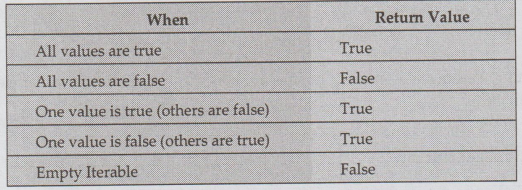
Example
:
>>>
a=[10,0,20,30,40]
>>>
print(any(a))
True
>>>
b=[ ]
>>>
print(any(b))
False
>>>
c=[False 01
>>>print(any(c))
False
>>>
3)
len(): This function returns the number of items present
in the list
Syntax
:
len(List)
Example
:
>>> a=[10,20,30,40,50]
>>>
print("The length of list a is: ",len(a))
The
length of list a is: 5
>>>
4)
list(): This function converts an iterable to a list
Syntax
:
list([iterable])
The
list() constructor returns a mutable sequence list of elements.
If
no parameters are passed, it creates an empty list
If
iterable is passed as parameter, it creates a list of elements in the iterable
Example
:
>>>print(list())
[
]
>>>
mystr="hello"
>>>
print(list(mystr))
['h',
'e', 'T', 'T', 'o']
>>>
mytuple=('h', 'e','T,T,'0')
>>>
print(list(mytuple))
['h',
'e', 'T', 'T', 'o']
>>>
5)
max(): This function returns the maximum value element
from the list.
Syntax
:
max(iterable)
The
maximum value from the iterable is returned.
Example
:
>>>
a=[1,2,3,55,7]
>>>print(max(a))
55
>>>
6)
min(): This function returns the minimum value element
from the list.
Syntax
:
min(iterable)
The
minimum value from the iterable is returned.
Example:
>>>
a=1100,10,1,20,30]
>>>print(min(a))
1
>>>
7)
sum(): This function adds the items of iterable and the
sum is retunred.
Syntax
:
Sum(iterable,
start)
The
sum of all the elements from the iterable is returned. The start is optional.
If start value is mentioned then it is added to the sum.
Example
:
>>>
a=[1,2,3,41
>>>
result=sum(a)
>>>
print(result)
10
>>>
start=100
>>>
print(sum(a,start))
110
>>>
4. List Loop
The
Loop is used in list for traversing purpose. The for loop is used to traverse
the list elements
Syntax
for
VARIABLE in LIST :
BODY
Example
>>>
a=['a','b','c','d', 'e'] # List a is created
>>>
for i in a: print(i)
will
result into
a
b
c
d
e
>>>
If
me want to update the elements of the list, then we must pass index as argument
to for loop. For example
>>>
a=[10,20,30,40]
>>>
for i in range(len(a)):
a[i]
= a[i]+1 #incremented each number by one
>>>
a
[11,
21, 31, 41]
>>>
If
we specify the [ ] empty list then the body of for loop will never get
executed.
>>>
for i in [1:
print("This
line will never execute")
>>>
5. Mutability
•
Strings are immutable. That means, we can not modify the strings.But Lists are
mutable. That means it is possible to change the values of list.
•
If the bracket operator is present on the left hand side, then that element is
identified and the list element is modified accordingly.
For
example
>>>
a=['AAA','BBB','CCC')
>>>
a[1]='XXX
>>>
a
['AAA',
'XXX', 'CCC')
>>>
Using
the in operator we can check whether particular element belongs to the list or
not. If the given element is present in the list it returns True otherwise
False. For example
>>>
a = ('AAA', 'XXX', 'CCC')
>>>
'XXX' in a
True
>>>
'BBB' in a
False
>>>
6. Aliasing
Definition
:
An object with more than one reference has more than one name, so we say that
the object is aliased.
For
example -
>>>
x = {10,20,30]
>>>
y = x
>>>
y is x
True
>>>
y
[10,
20, 30]
>>>
The
association of a variable with object is called reference.
In
above example, reference y is created using object a. Diagrammatically aliasing
is shown in Fig. 4.1.1.
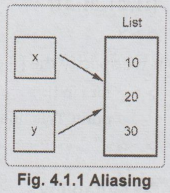
Fig.
4.1.1 Aliasing
If
any change is made in one reference then other object gets affected. For
example
>>>
x=[10,20,30]
>>>
y = x
>>>
y
[10,
20, 30]
>>>
y[0]=111
>>>y
[111,
20, 30]
>>>
x
[111,
20, 30]
>>>
Note
that in above list if we change the reference list y then the list x also gets
changed automatically
7. Cloning Lists
Cloning
means creating exact replica of the original list. There are various method
using which we can clone the list.
1.
Cloning by assignment
We
can assign one list to another new list. This actually creates a new reference
to the original list.
For
example
>>>
a=['a','b', 'c']
>>>
b = a
>>>
b
['a',
'b', 'c']
>>>
Note
that here list bis a clone of original list a. But as the reference is created
change in one list causes change in another list.
2.
Cloning by slicing
We
can create a clone by slicing. During this process, [:] operator is used for
creating the clone. For example
>>>
a = [10,20,30]
>>>
b = a[:]
>>>
print(" List a =",a)
List
a = [10, 20, 30]
>>>
print(" List b=",b)
List
b= [10, 20, 30]
>>>
b[1]=222
>>>
print("List b= ",b)
List b= [10, 222, 30]
>>>
print("List a="/a)
List
a= [10, 20, 30]
>>>
Note
that the clone b is created from the list a. But change in one list does not
affect the other list
The
operator [:] means copy the elements in one list from beginning to end into
another list.
3.
Clone by copy constructor
We
can create a clone for the list using copy constructor. This is just similar to
clone by slicing. The list function is used to create the clone. For example
>>>
a = ['A','B','C']
>>>
b = list(a)
>>>
b
['A',
'B', 'C']
>>>
a
['A',
'B', 'C']
>>>
Note
that even if we make changes in the clone list, the other list does not get
changed. For example
>>>
a
['A',
'B', 'C']
>>>
b[1]='Z
>>>
b
['A',
'Z', 'C')
>>>
a
['A',
'B', 'C']
>>>
8. List Parameters
A
list can be passed as a parameter to the function. This parameter is passed by
reference. That means any change made in the list inside the function will
affect the list even after returning the function to the main.
For
example :
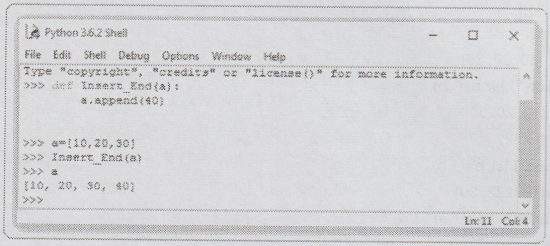
In
above screen-shot, the python code is written in interactive mode. The function
Insert_End is for inserting the element at the end of the list.
Here
we pass the list a as parameter to the function. Inside the function, the
element is added at the end of the list. Hence after the making call to the
function, we get the list in which the element is inserted at the end.
Example
4.1.1 Write a Python program to remove duplicates from
a list
Solution
:
a
= [1,2,3,2,1,4,5,4,8,5,4]
duplicates
= set()
for
x in a:
if
x not in duplicates :
duplicates.add(x)
print(duplicates)
Output
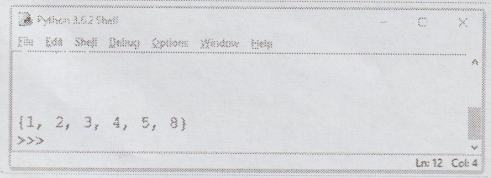
Example
4.1.2 Write a Python program to read a list of words
and return the length of longest one
Solution
:
a
= [ ]
print("Enter
the number of words in list:")
n
= int(input())
for
i in range(0,n):
item
= input("Enter word" + str(i+1) + ":")
a.append(item)
max_len
= len(a[0])
temp
= a[0]
for
i in a:
if(len(i)
> max_len):
max_len
= len(i)
temp
= i
print("The
longest length word is ")
print(temp)
Example
4.1.3 Write a Python program to print the maximum
among 'n' randomly generate 'd numbers by storing them in a list.
AU
: Dec.-19, Marks 10
Solution
:
import
random
def
Max_from_random(s,e,n):
ran
= [ ]
for
i in range(n):
ran.append(random.randint(s,
e))
print("The
generated numbers are: ",ran)
max_num
= ran[0]
for
ele in ran:
if(ele>max_num):
max_num
= ele
return
max_num
#
Driver Code
n
= int(input("How many Random Numbers want to disaply ::'))
s
= int(input("Enter Starting number ::"))
e
= int(input("Enter Ending number ::"))
print(Max_from_random(s,
e, n))
Output
How
many Random Numbers want to disaply ::10
Enter
Starting number ::1
Enter
Ending number ::10
The
generated numbers are: (8, 2, 4, 9, 7, 4, 2, 6, 8, 5]
9
>>>
Example
4.1.4 Write a Python program to rotate a list by right
n times with and without slicing technique.
AU
: Dec.-19, Marks 4+4
Solution
:
arr1
= [1, 2, 3, 4, 5]
print("Original
List : " + str(arr1))
print("Rotating
a list by 3 using slicing technique")
arr1
= arr1[-3:] + arr1[:-3]
print(arr1)
arr2
= [11,22,33,44,55]
print("Original
List : " + str(arr2))
n
= 3
print("Rotating
a list by 3 without using slicing technique")
for
i in range(0,n):
last
= arr2[len(arr2)-1]
for
j in range (len(arr2)-1,-1,-1):
#shift
element of array by one
arr2[j]
= arr2[j-1]
arr2[0]
= last
print(arr2)
Output
Original
List : [1, 2, 3, 4, 5]
Rotating
a list by 3 using slicing technique
[3,
4, 5, 1, 2]
Original
List : [11, 22, 33, 44, 55]
Rotating
a list by 3 without using slicing technique
[33,
44, 55, 11, 22]
Review Questions
1. Discuss different options to traverse a list.
AU : Dec.-19, Marks 8
2. Demonstrate the working of +, * and slice operators in
python.
AU : Dec.-19, Marks 8
3. How will you update list items ? Give one example.
AU : Dec.-19, Marks 2
4. Compare lists and arrays with example. Can list be considered
as an array? Justify.
AU : Dec.-19, Marks 6
Problem Solving and Python Programming: UNIT IV: Lists, Tuples, Dictionaries : Tag: Engineering Python : Syntax, Example Program | Python Programming - Lists
Related Topics
Related Subjects
Problem Solving and Python Programming
GE3151 1st Semester | 2021 Regulation | 1st Semester Common to all Dept 2021 Regulation
